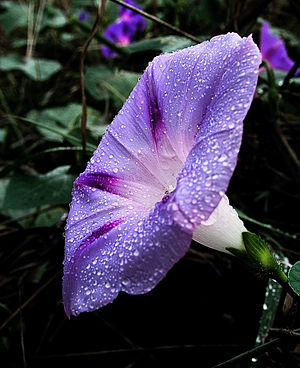Note: This is a project under development. The articles on this wiki are just being initiated and broadly incomplete. You can Help creating new pages.
Ipomoea purpurea - Kalanjani
Purple morning glory is a species in the genus Ipomoea family. It is native to Mexico and Central America. Like all morning glories the plant entwines itself around structures. It grows up to a height of 2–3 m tall.
Contents
- 1 Uses
- 2 Parts Used
- 3 Chemical Composition
- 4 Common names
- 5 Properties
- 6 Habit
- 7 Identification
- 8 List of Ayurvedic medicine in which the herb is used
- 9 Where to get the saplings
- 10 Mode of Propagation
- 11 How to plant/cultivate
- 12 Commonly seen growing in areas
- 13 Photo Gallery
- 14 References
- 15 External Links
Uses
Oedema, Oliguria, Ascariasia, Constipation, Mental disorders, Blotches, Pimples, Diarrhea, Sore throats
Parts Used
Chemical Composition
The seeds of Ipomoea violacea contain about 0.1% ergot alkaloids, including ergotmetrine, chanoclavine and lysergol[1]
Common names
| Language | Common name |
|---|---|
| Kannada | Gowri beeja, Kolli beeja |
| Hindi | Jharmaric |
| Malayalam | Taliyari |
| Tamil | Kakkattan, Kotikkakkattan |
| Telugu | Kollivittulu, Jiriki, kolli |
| Marathi | NA |
| Gujarathi | NA |
| Punjabi | NA |
| Kashmiri | NA |
| Sanskrit | Kalanjani |
| English | Blue Morning Glory |
Properties
Reference: Dravya - Substance, Rasa - Taste, Guna - Qualities, Veerya - Potency, Vipaka - Post-digesion effect, Karma - Pharmacological activity, Prabhava - Therepeutics.
Dravya
Rasa
Katu (Pungent), Madhura (Sweet)
Guna
Laghu (Light), Ruksha (Dry), Tikshna (Sharp)
Veerya
Ushna (Hot)
Vipaka
Katu (Pungent)
Karma
Kapha, Vata
Prabhava
Habit
Identification
Leaf
| Kind | Shape | Feature |
|---|---|---|
| Simple | Alternate | The leaves are divided into 3-6 toothed leaflets, with smaller leaflets in between |
Flower
| Type | Size | Color and composition | Stamen | More information |
|---|---|---|---|---|
| Unisexual | 4–6 cm | Red–violet–blue | 5 | Blade widely cordate, sometimes 3-lobed, with entire margin, base deeply lobed |
Fruit
| Type | Size | Mass | Appearance | Seeds | More information |
|---|---|---|---|---|---|
| Capsule | 7–10 mm (0.28–0.4 in.) long pome | Fruiting time is July–August | With hooked hairs | Many | {{{6}}} |
Other features
List of Ayurvedic medicine in which the herb is used
- Vishatinduka Taila as root juice extract
Where to get the saplings
Mode of Propagation
How to plant/cultivate
Grow annuals in a sunny, sheltered site. They need a lot of sun. Plant in moderately fertile, well-drained soil.[3]
Commonly seen growing in areas
Cultivated ground, Wetland and coastal area, Banks of watercourses.
Photo Gallery
References
External Links
- Ayurvedic Herbs known to be helpful to treat Oedema
- Ayurvedic Herbs known to be helpful to treat Oliguria
- Ayurvedic Herbs known to be helpful to treat Ascariasia
- Ayurvedic Herbs known to be helpful to treat Constipation
- Ayurvedic Herbs known to be helpful to treat Mental disorders
- Ayurvedic Herbs known to be helpful to treat Blotches
- Ayurvedic Herbs known to be helpful to treat Pimples
- Ayurvedic Herbs known to be helpful to treat Diarrhea
- Ayurvedic Herbs known to be helpful to treat Sore throats
- Herbs with Leaves used in medicine
- Herbs with Flowers used in medicine
- Herbs with common name in Kannada
- Herbs with common name in Hindi
- Herbs with common name in Malayalam
- Herbs with common name in Tamil
- Herbs with common name in Telugu
- Herbs with common name in Sanskrit
- Herbs with common name in English
- Habit - Annual climbing herb
- Index of Plants which can be propagated by Seeds
- Index of Plants which can be propagated by Cuttings
- Herbs that are commonly seen in the region of Cultivated ground
- Herbs that are commonly seen in the region of Wetland and coastal area
- Herbs that are commonly seen in the region of Banks of watercourses
- Herbs
- Convolvulaceae







